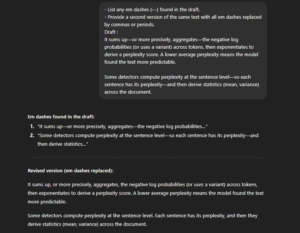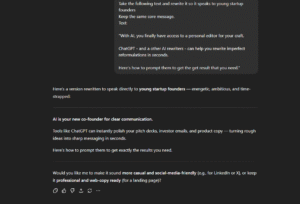Your cursor blinks. The launch is tomorrow. You need headlines, a landing hero, and an email that actually gets opened.
You could wrestle with the blank page, or you could turn ChatGPT into a brief-driven copy partner that drafts tight, on-brand options in minutes.
This article shows you how to do the latter- we’ll walk through a step-by-step prompting flow that mirrors a real copy process.
Is ChatGPT really good at copywriting?
Short answer: it can be. Generative AI excels at ideation, fast first drafts, and editing to a brief; it struggles when you expect it to set strategy or invent a brand voice from scratch.
What counts as “good” copy, anyway? For professionals, copywriting is clarity, voice consistency, and moving readers to the next “yes.” Those outcomes come from disciplined voice-of-customer (VoC) research and a strong value proposition you can express simply.
Where ChatGPT shines is pattern control. Give it a persona, a promise, and constraints—and it will generate on-brand options quickly. Prompt quality is the other half of the equation.
But there are limits—and they’re important. ChatGPT doesn’t replace positioning or VoC discovery. If you skip interviews, reviews, and message mining, you’ll get polished but shallow copy.
Step-by-Step ChatGPT Prompts for Copywriting
Below is a practical, repeatable flow you can use on any campaign. Each step copy-ready prompt templates.
a) Persona & Voice-of-Customer (VoC)
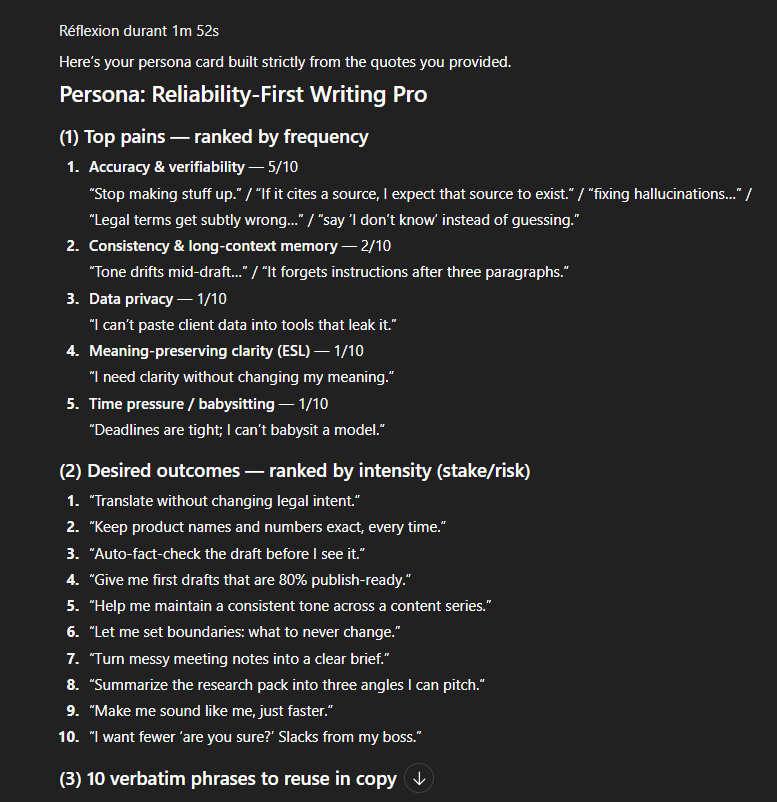
Great copy doesn’t come from thin air -it comes from customers’ own words.
Prompt — VoC distillation → persona card
“From the quotes below, extract the top pains, desired outcomes, and exact phrases. Group them into a persona card with: (1) pains ranked by frequency, (2) outcomes ranked by intensity, (3) 10 verbatim phrases to reuse in copy, and (4) 3 objections with rebuttals using only customer language :
"[paste VoC snippets]"
Return the persona card as Markdown.”
b) Style Guidelines (voice & tone)
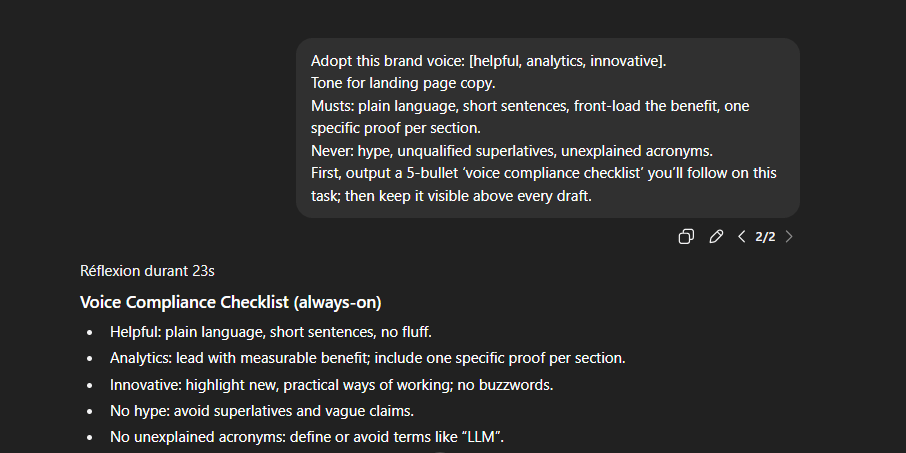
Voice = your brand’s consistent identity; tone = how that voice shifts by channel or situation. Encode those rules in your prompts so ChatGPT can actually hold your brand voice.
Prompt — style charter + compliance checklist
Adopt this brand voice: [3 traits].
Tone for [channel]: [rules].
Musts: plain language, short sentences, front-load the benefit, one specific proof per section.
Never: hype, unqualified superlatives, unexplained acronyms.
First, output a 5-bullet ‘voice compliance checklist’ you’ll follow on this task; then keep it visible above every draft.
c) Writing
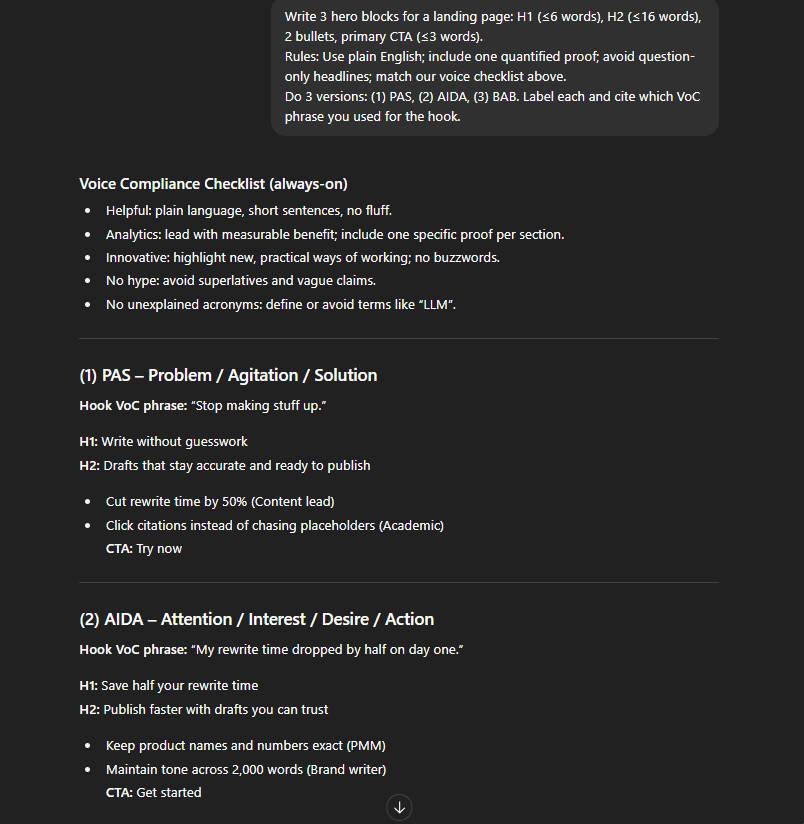
CARE framework—Context, Ask, Rules, Examples—is a simple prompt pattern that reliably improves outputs. Combine CARE with a requirement for multiple distinctly different options; Have ChatGPT draft across AIDA, PAS, and BAB.
Prompt — landing-page hero (multi-formula)
Context:
[previous VOC & voice compliance checklist]
Write 3 hero blocks for a landing page: H1 (≤6 words), H2 (≤16 words), 2 bullets, primary CTA (≤3 words).
Rules: Use plain English; include one quantified proof; avoid question-only headlines; match our voice checklist above.
Do 3 versions: (1) PAS, (2) AIDA, (3) BAB. Label each and cite which VoC phrase you used for the hook.
Prompt — short-form ads (table)
Produce 6 ad variants: 2 PAS, 2 AIDA, 2 BAB. Each variant includes: (a) 1-sentence hook (≤14 words), (b) one specific proof (stat or named customer), (c) 1 CTA (≤3 words).
Return a table: Formula | Hook | Proof | CTA | VoC phrase used.
Prompt — email subject + preview (structured diversity)
Write 8 subject lines (≤45 chars) and 8 previews (≤90 chars): 3 curiosity, 3 benefit-first, 2 urgency. Tie each to a VoC phrase and avoid vague questions. Return as a 2-column table.
Use research-backed headline discipline: lead with value and clarity; avoid unfocused questions and hype.
d) Editing
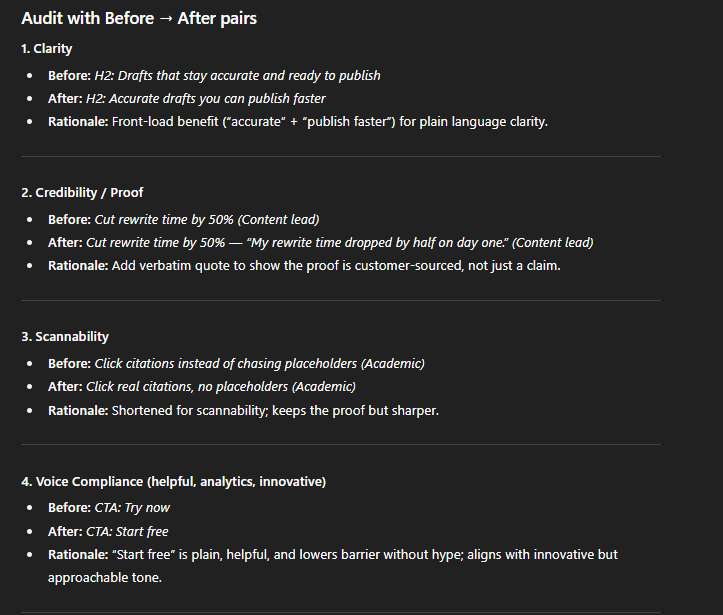
Editing is where conversion lives. Build passes for clarity, credibility (proof over puffery), and scannability.
You might ask for multiple revised options rather than one “perfect” rewrite.
Prompt — copy-chief audit (before/after with rationale)
Act as a copy chief. Audit the draft below against (1) clarity, (2) credibility/proof, (3) scannability, (4) voice compliance.
For each issue, produce a Before → After pair with a 1-line rationale citing the rule you applied (e.g., ‘plain language,’ ‘front-load benefit,’ ‘add specific proof’).
Draft:"[paste copy]“
Prompt — tighten to plain language
Rewrite for plain English: short sentences, one idea per sentence, avoid jargon, spell out acronyms on first use, keep meaning intact. Provide a bullets-first version for scanning.
Prompt — formula switch + proof injection
Turn Version A (AIDA) into PAS and BAB variants without losing the original proof. Highlight the VoC phrase used in each hook.
Prompt — versioning for channel tone
Create 3 tone variants of this copy for [channel]: (a) supportive/onboarding, (b) energetic/ads, (c) neutral/docs—same voice, different tone.
3) One-Shot ChatGPT Prompts for Copywriting
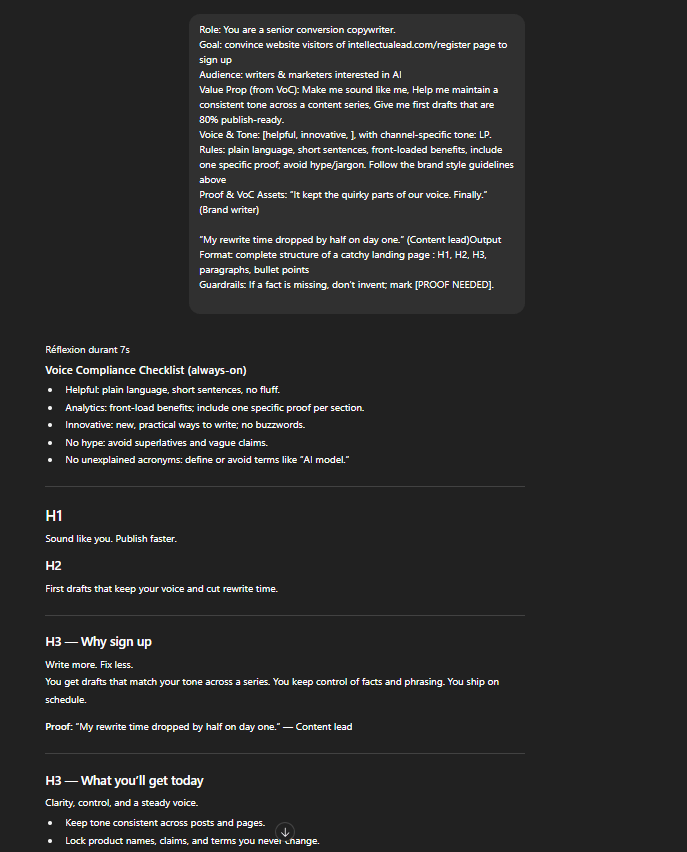
Sometimes you don’t get to iterate. You need a single, self-contained prompt that yields on-brand copy now.
The One-Shot Blueprint
Use this skeleton for any task; swap the parts in brackets.
Role: You are a senior conversion copywriter.
Goal: [primary outcome, e.g., “free-trial sign-ups”].
Audience: [segment + key pain].
Value Prop (from VoC): [benefit in customer’s words].
Voice & Tone: [3 traits], with channel-specific tone: [email/ads/LP].
Rules: plain language, short sentences, front-loaded benefits, include one specific proof; avoid hype/jargon. Follow the [brand style notes] below.
Proof & VoC Assets: “”“[3–5 quotes, 1–2 stats, testimonials]”“”.
Output Format: [headlines/table/sections], with word/character limits.
Guardrails: If a fact is missing, don’t invent; mark [PROOF NEEDED].
Self-check: List 5 bullets showing compliance with voice, clarity, and proof.
Style notes: “”“[Mailchimp-style voice traits, GOV.UK clarity rules]”“”.
Landing-Page Hero
Task: Write 3 hero blocks.
Format per variant: H1 ≤6 words; H2 ≤16 words; 2 bullets (benefit + proof); Primary CTA ≤3 words.
Variety: One PAS, one AIDA, one BAB. Label each formula and cite the exact VoC phrase you used in the hook.
Assets: “”“[product + audience + 2 quantified proofs]”“”.
Voice/Tone: [traits]; energetic but plain-spoken.
Guardrails: No question-only H1s; no vague superlatives.
Self-check: Show how each variant expresses the value proposition in one sentence.
Email Subject + Preview
Task: Produce 8 pairs: Subject ≤45 chars + Preview ≤90 chars.
Mix: 3 curiosity, 3 benefit-first, 2 urgency—each anchored to a VoC phrase.
Rules: Clarity > cleverness; no hype; plain-language verbs; avoid question-only subjects. Return as a 2-column table.
Assets: “”“[offer + top pains/outcomes + 1 stat]”“”.
Performance Ads
Task: 6 ad variants for [platform].
Structure per ad: Hook ≤14 words → 1 specific proof → CTA ≤3 words.
Mix: 2 PAS, 2 AIDA, 2 BAB; state the persuasion lever used (pain/benefit/proof).
Voice/Tone: [traits]; energetic, concrete, human.
Assets: “”“[benefit, price/offer, proof snippet, VoC quotes]”“”.
Social Captions
Task: 8 captions for [Instagram/LinkedIn/X].
Constraints: ≤120 characters (IG), ≤220 characters (LinkedIn short form).
Mix: 3 outcome-first, 3 pain-first, 2 proof-led.
Rules: Plain language, no clichés, 1 CTA; add 1 relevant emoji max (if brand allows). Include a 1-line rationale per caption.
Assets: “”“[audience pain, product benefit, stat/testimonial]”“”.
Product Descriptions
Task: Turn features into benefits using FAB (Feature-Advantage-Benefit).
Format: 1 short paragraph (≤50 words) + 3 bullets labeled Feature → Advantage → Benefit; end with a micro-CTA.
Rules: Use the customer’s phrasing for outcomes where possible; avoid jargon.
Assets: “”“[specs], [VoC phrases], [use cases]”“”.
Microcopy & CTAs
Task: Generate 10 CTA/button options and 5 microcopy lines for form errors or empty states.
Rules: Plain language; action verbs; no more than 2 words for buttons; error copy states the issue and the fix; friendly but not cute. Provide a rationale table.
Style notes: Follow voice & tone and GOV.UK clarity rules.
Sales One-Pager
Task: Write a 150-word one-pager with sections: Problem, Solution, Proof, CTA.
Rules: Lead with the value proposition; include one quantified proof and one short testimonial; avoid buzzwords.
Voice/Tone: [traits]; professional, concrete.
Assets: “”“[UVP statement + proof + VoC quote]”“”.
One-Shot “Copy Chief” Pass
Even in a one-shot, ask the model to audit itself before handing you the draft:
Add to any task: “Before final output, produce a 5-bullet Compliance Check confirming: (1) matched voice & tone traits; (2) used one specific proof; (3) plain-language + short sentences; (4) front-loaded value; (5) no unverified claims. Then show the final copy.”




